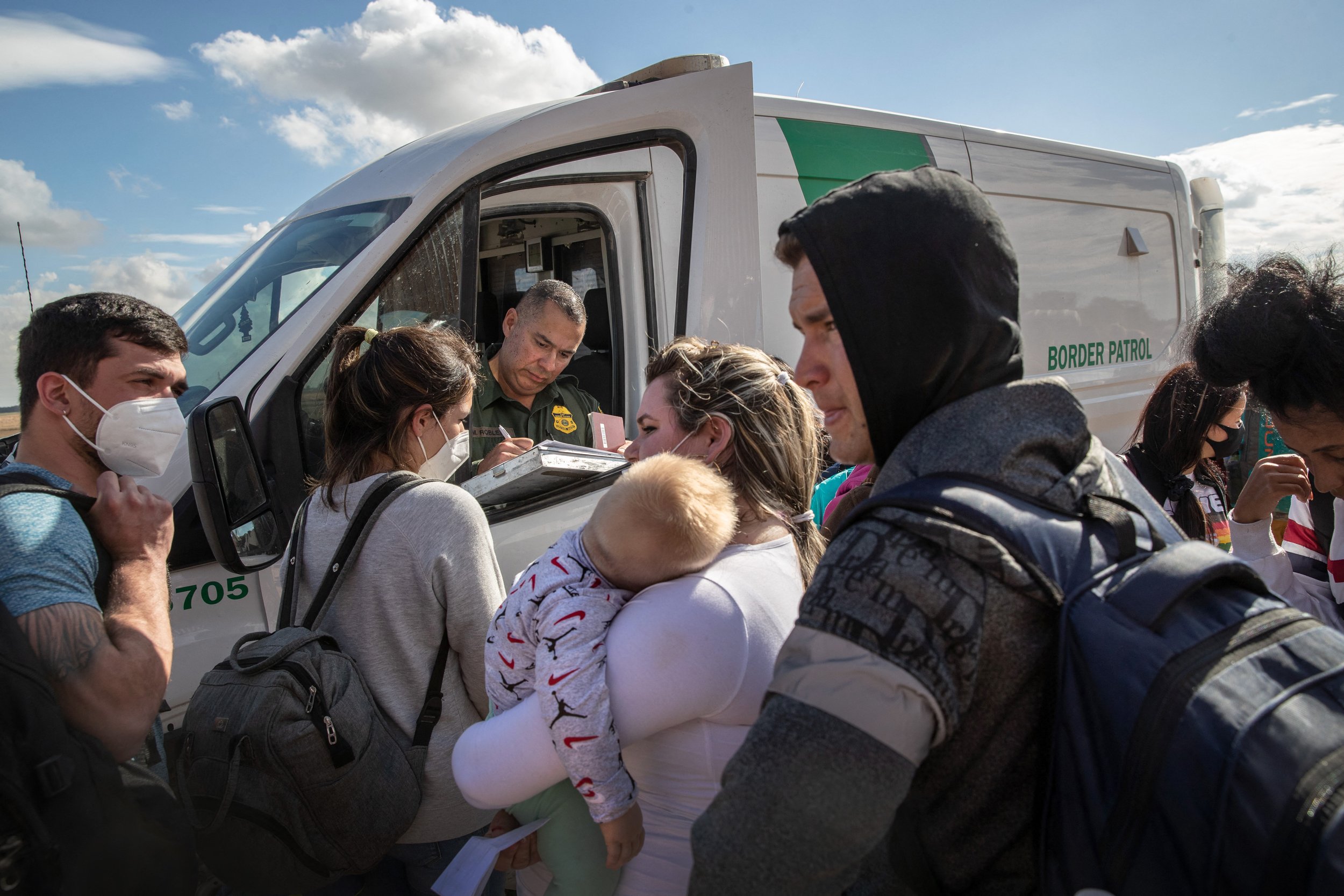Asylees Run Up Against Biden’s Border Policy
A family from Cuba waits to be transported to a U.S. Border Patrol processing center on December 9, 2021 in Yuma, Arizona. [John Moore/Getty Images via AFP]
To Texas Gov. Greg Abbott (R), an increase in people crossing the southern border is nothing less than an existential threat to America’s existence.
During his time in office, Abbott has spent more than $3 billion trying to lock down the border, promoting his program with racist rhetoric. Absent from this nativist propaganda are the many factors that drive people to leave their countries in the first place, which include the pandemic, collapsing economies and political pressures, as well as changing visa requirements within Latin America.
More people tried to enter the U.S. in March than at any point in the past two decades, and it’s important to know the real reasons why, and how they’re actually being treated. While Biden took office with promises to reverse the Trump administration’s hard-line immigration policies, untangle the thicket of restrictive legislation, and fight conservative lawmakers intent on defending it, it’s been an uphill battle all the way. To make sense of what’s going on, I spoke with Jessica Bolter, an associate policy analyst at the liberal Migration Policy Institute.
This interview has been edited for length and clarity.
What’s been happening at the border since the beginning of the year?
Over the past several months, we've seen many more people arrive at the U.S.-Mexico border than in recent years. In March, we saw more than 210,000 instances of people crossing the border illegally, which is the highest monthly number since 2000. At the same time, not all of these encounters result in people being released into the U.S.: In March, about half led to people being immediately expelled to Mexico or their country of origin. So while we're seeing elevated levels of crossings, we're still also consistently seeing people being expelled and denied access to the asylum system.
Do you know what some of the driving factors are behind the spike in migration?
It varies, but there are some overarching factors. First of all, we've seen economies throughout Latin America and the Caribbean really struggle as a result of COVID and related lockdowns. We've seen poverty increasing and employment decreasing in these countries, and meanwhile the U.S. economy is opening back up.
There also has been a perception that the Biden administration would treat people crossing the border more leniently than the Trump administration did. There is a kernel of truth in this – the Biden administration terminated the "Remain in Mexico" program, and it exempted unaccompanied children from expulsion.
There were also some policies that the Biden administration wasn't in control of; namely, the decision of several Mexican state governments not to accept families with young children who the U.S. would otherwise expel. On top of that, migration has really been facilitated by options for legal travel to the U.S.-Mexico border. We saw this with Brazilians, Ecuadorians and Venezuelans, who until recently were able to enter Mexico without a visa, which allowed them to easily fly to Mexico and then make their way to the border.
Something similar is currently happening with Cuban migration, which has really spiked since Nicaragua removed a visa requirement for Cubans in November 2021. So Cubans are able to fly into Nicaragua and jump-start their land journey to the U.S. from there.
What's happening in Cuba that’s driving this migration?
Between October 2021 and March 2022, there were 79,000 encounters of Cubans at the U.S.-Mexico border, which is the highest number we've seen going back to at least the '90s, which is as far back as we have data. The last time this many Cubans arrived without authorization in the U.S. was in 1980, when 125,000 arrived by boat in Florida. This is obviously facilitated by Nicaragua's policy, but there are other factors.
First, Cuba is experiencing its worst economic crisis since the 1990s. The Cuban economy was struggling even before the pandemic – because of increased sanctions imposed by the Trump administration, tighter restrictions on remittances, shrinking aid from Venezuela – and these problems were exacerbated by the onset of the pandemic, especially in the tourism sector.
We've also seen increasing internal frustration with the Cuban government. Anti-government protests broke out in July 2021, which are incredibly rare in Cuba, and the official response was mass detentions and prosecutions. So people may be fleeing because they think they'll be targeted, or because there's a sense of hopelessness.
Finally, another big factor is that it's been extremely difficult for Cubans to travel to the U.S. legally since the Trump administration shut down visa services at the American embassy in Havana in 2017.
You mentioned earlier that the Biden administration ended the “Remain in Mexico” policy. What’s the status of that now?
Well, it's been a bit of a roller coaster. As soon as the Biden administration took office, it suspended new enrollments in "Remain in Mexico," or MPP [which previously enabled officials to send people to potentially dangerous parts of Mexico as they awaited a decision on their applications]. Then, in June 2021, it officially terminated the program. But two months later, Texas and Missouri sued the administration to challenge the termination of MPP, and a federal judge required the government to reactivate the program. So MPP was reactivated in December 2021, and is still in place.
Since then, the administration has sent about 2,000 people back to Mexico. The dispute over whether the government is legally allowed to terminate MPP is now at the Supreme Court, and a decision is expected by June.
What are other rationales that the U.S. government has used to expel people?
Title 42 is a public health rule that the Center for Disease Control invoked in March 2020 to justify the expulsion of people who crossed into the U.S. illegally, often within hours of their arrival.
The justification was that these individuals couldn't be detained for significant periods of time because there was a worry about them spreading COVID. As a result, people who come here are not given access to the U.S. asylum system, even if they say they fear persecution in their country of origin. The Biden administration has announced that it will terminate Title 42 on May 23, but a group of Republican-led states have sued to block the administration from doing so. A hearing is set for May 13.
How would you characterize immigration policy in the U.S. right now?
It's become extremely difficult to make any lasting changes to the immigration system because Congress has proven unwilling to take on these complex issues or make compromises. So in the absence of any sort of legislative prospects, immigration policy is now decided by executive actions and court rulings, which leads to a lot of confusion.
Having said that, the Biden administration has made nearly 600,000 additional people eligible for legal protections under temporary protected status. So, some important changes have been made. Still, border policies tend to be very reactive.




